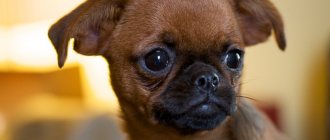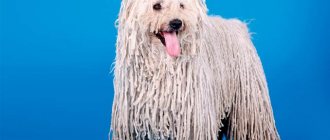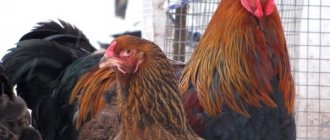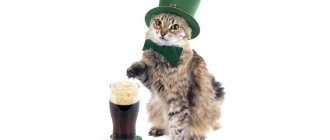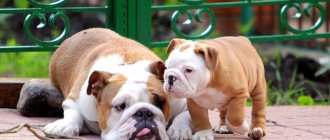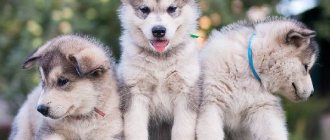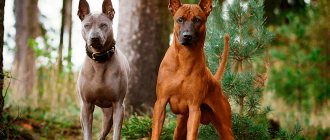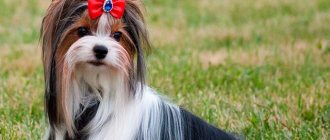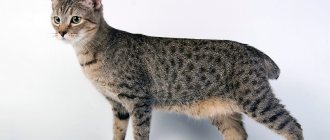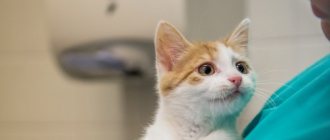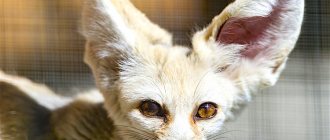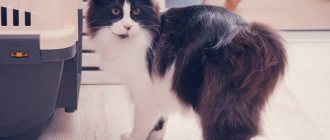When choosing a small decorative dog, you should pay attention to the Petit Brabançon breed. These dogs have a lively disposition and a sharp mind, and are strongly attached to their owner and his family. Dogs are not demanding in care, but there are certain nuances in their maintenance and upbringing.
Brief history of origin
Petit Brabançons were bred in Belgium. They appeared back in the 19th century, but the documents that confirmed this were provided to society much later.
The Petit Brabançon was formed by crossing the following dog breeds:
- The Affenpinscher gives this breed its expressive flat muzzle and coarse coat.
- The King Charles Spaniel influenced the colors of the Petit Brabançons, the structure of the tail, and also the paws.
- Black pugs inherited the structure of the body and face, as well as the color and smooth coat.
- Papillon influenced the dimensions.
Thanks to the crossing of the above-described breeds, the Petit Brabançon has a dome-shaped skull, large expressive eyes and a flat muzzle.
Interesting! Petit Brabançons first appeared between 1870 and 1880. The exact date is unknown, as they were bred by grooms from Belgium who did not keep records of their activities.
The new breed won the hearts of the nobility, who liked small, unusual dogs. They lived in palaces and accompanied their aristocratic masters everywhere. Owners valued these dogs for their playful disposition, loyalty, ease of care, and passion for catching small rodents. The latter feature aroused interest in the breed among the middle strata of society, who also sought to have this dog.
In 1880, Petit Brabançon took part in an exhibition in Brussels. The dog immediately attracted everyone's attention. This is how the breed gained popularity, and the cost of the animal immediately increased. This led to unscrupulous breeders starting to crossbreed Petit Brabançons with different dogs. For this reason, they have lost some of their unique features.
This breed could have disappeared without a trace if not for Duchess Henrietta of Belgium. She made a lot of efforts to revive and increase the dog population. They participated in annual exhibitions, where they were invariably successful.
A few years later, the Belgian authorities gave permission for the sale of Petit Brabançons abroad. However, the Second World War began, which negatively affected their numbers. They did not disappear completely just because some dogs lived in Great Britain and America. After the war, the breed was preserved by breeders. However, their appearance has changed slightly.
The breed standard was updated in 1963, and then in 2003.
The first representatives came to the CIS countries from America in 1993. Breeders from St. Petersburg started breeding them. After 6 years, the number of dogs increased to 85.
Interesting Facts
Future and current owners of Petit Brabançons should know the following key facts about the dog:
- This breed has several names: Petit Brabançon, Petit Brabançon, Brabant Griffon, Smooth-haired Griffon.
- This dog is calm, it will not show aggression towards others without reason, it is not suitable for the role of guard dogs, as it is an excellent companion.
- They are inquisitive, love communication and fun games.
- Dogs form a strong bond with their owner and his family. Prolonged loneliness is dangerous for the Petit Brabançon; he can even get sick.
- If you leave a dog with strangers, it will behave capriciously, be stubborn, cunning, and even run away from its temporary housing to find its owner.
- Adult Petit Brabançons remain as playful as when they were children.
- The puppy's intelligence corresponds to the development level of a 3-year-old child. Therefore, he understands what his owner wants from him, learns quickly and retains this skill.
- Dogs intuitively sense their owner’s mood and adapt to it.
- Petit Brabançons love to travel; they are not afraid of different types of transport and large crowds of people. They especially like picnics.
- Petit Brabançons can bring into the house various objects that they find on the street. This is due to their instinct as rodent catchers.
Interesting! The name petit-Brabançon comes from the French word petit - small, brabancon - province of Brabant (Belgium). However, the representative of this breed is not the smallest among the Belgian Griffons.
Key points in training
Even decorative dogs need to be trained. You need to start from birth. The puppy must understand who is boss in the house, what can and cannot be done. There are several rules to establish a hierarchy:
- Ban on playing on human furniture;
- Begging is prohibited; feeding takes place only after the family gets up from the table;
- A person enters the house first;
- Barking without reason is punished;
- The owner is always the authority.
A spoiled puppy will be difficult to re-educate at an older age. From 3 months, babies are trained in a targeted manner. They start with simple commands, remembering the name, daily routine. Kennel clubs recommend completing the “Dog in the City” program. It turns on all the necessary signals, they will help the pet navigate the city space and make walks safe.
By six months the dog should know its name and basic commands:
- "sit";
- "place";
- "near";
- "it is forbidden";
- "voice".
Pettit needs mental training. Therefore, after learning all the necessary words, they switch to visual signals or a whistle.
Breed description, standards, appearance
The Petit Brabançon has strong bones and well-developed muscles. Future owners need to know what a Petit Brabançon dog should look like. This information will help distinguish a healthy animal from a dog with poor genetics.
When assessing the appearance of a Petit Brabançon, you should pay attention to the size, structural features of the body, color, and coat type.
Also, the owners of these dogs should know what diseases they are susceptible to, why they occur, and how to prevent them. Then their Petit Brabançons will live a long and happy life.
Size and constitution
The description of the Petit Brabançon breed states that the height of the dogs is in the range of 16–26 cm. By height we mean the height at the withers - the highest point of the back at the level of the shoulder blades.
The sizes of dogs depend on gender:
- males – from 20 to 26 cm;
- females - from 16 to 22 cm.
The weight of Petit Brabançons ranges from 3 to 6 kg. The body weight of a male is from 4 to 6 kg, and that of a female is from 3 to 5 kg.
Attention! According to the standard, the length of the body from the ischial tuberosities (the bony protrusions in the lower part of the pelvis) should be almost identical to the height of the dog.
Externally the dog is small, but physically developed. He is stocky and has strong, almost square bones. The withers (the area between the shoulder blades) are slightly raised. The lumbar region is short, slightly protruding, the muscular corset is developed. In general, the back is short, level, and strong. The back of the body is straight, wide, slightly sloping.
The chest is convex and wide. The ribs are slightly rounded, the stomach is tucked, the groin line is clearly defined.
The head is small, but in comparison with the bones it is large. But its flattened muzzle makes it appear smaller. The skull is round, wide, and the forehead is sloping.
The Petit Brabançon's muzzle is about 1.5 cm long. It is slightly raised upward.
Normally, a Petit Brabançon's mouth is always closed, the lips cover the teeth, and the tongue is not visible. The normal type of bite for them is an underbite (the upper jaw is shorter and the lower jaw protrudes forward). The lower jaw is wide, slightly curved upward. In a healthy dog, the incisors (top and bottom) are at the same level.
The eyes are large, round, but not as bulging as, for example, those of the Pekingese. They are set wide, slightly slanting. The iris is a rich brown color, the edges are outlined in black, the whites should not be noticeable. The eyelids are tightly stretched and pigmented.
The ears are set high and the distance between them is quite large. They are usually semi-erect, hanging forward slightly. After docking (which is done less and less often), they are erect and have sharp tips.
The Petit Brabançon's nose is wide and black with prominent nostrils. It is in line with the eyes. Its tip bends back slightly, so if you look at its muzzle from the side, it appears that the nose and forehead are placed in the same plane.
The dog's lips are tightly compressed and painted black. The lower lip slightly covers the upper lip.
The neck is of medium length, gradually blending into the shoulders.
The Petit Brabançon's tail is set high, with the tip pointing upward and towards the back, but not curled. As a rule, it is docked, then it becomes shorter by 2/3 of the total length.
The feet are round, small, parallel to each other, with the toes pointing forward (not in or out). The limbs have strong bones. The elbows in front are placed closer to the body, the hind legs have a low landing due to the hock joint. The toes are pressed tightly together, the paw pads and claws are thick and dark.
Professionals distinguish the following dog defects:
- elongated body or the presence of sagging areas;
- ribs barrel-shaped or flat;
- paws are crooked, pads and claws are light;
- excessively prominent, light-colored, slanted or small eyes;
- short (undocked) or curled tail;
- nose above or below eye level;
- large ears, rounded at the tips;
- height and weight above or below normal;
- the nose is not black or completely devoid of pigmentation;
- the mouth is closed, but the tongue is visible;
- incomplete set of incisors;
- the upper jaw protrudes above the lower jaw.
Individuals with such characteristics are not allowed for exhibitions or breeding.
Important! Disqualifying defects for Petit Brabançon include mental disorders. Then the dog is too shy or aggressive. This is not normal for healthy representatives of the breed.
Color and coat type
The Petit Brabançon is short-haired, the length of the hairs on its body is about 2 cm. The dog's coat is moderately hard, dense, thick, and shiny. The fur on the back, paws and muzzle is shorter than on the rest of the body. Petit Brabançons do not have long hairs on their muzzle or eyebrows.
The colors of this dog breed are varied:
- Black, without spots of other shades.
- Black and tan. The main color is black, and on the face, chest, paws (inner part), and tail there are spots of red shades.
- Ginger. The background is of different shades of red, there are areas of darkening on the face, ears, body, and tail.
- Chocolate. Dark red color with a golden tint. Such individuals are the most valuable.
Interesting! Among the Petit Brabançons there are fawn-colored individuals. The main color is light beige, there are white spots on the chest, paws and tail.
Breed faults include the presence of white hairs on the face or chest. Disqualifying faults are spots of white (with the exception of fawn), gray, bluish, or liver color.
Health and life expectancy
The description of the Petit Brabançon states that these dogs are in relatively good health. Problems can arise if the owner does not follow the rules of care and maintenance. For example, he feeds and cares incorrectly, refuses vaccination, and allows the dog to come into contact with street animals, which often carry dangerous infections.
Petit Brabançons are prone to eye and dental diseases:
- Retinal dystrophy. Pathology occurs due to hereditary predisposition or injury. The anatomy and/or function of the retina changes, leading to blindness over time.
- Protrusion of the eyeball - protrusion of the eyeball. The disease leads to stretching of the optic nerve and visual impairment. This problem is common in all dogs with a round skull and a flat face (especially Pekingese).
- Distichiasis is an extra row of eyelashes. They touch the surface of the cornea, which causes irritation and pain. The pathology threatens inflammation or ulceration of the cornea.
- Entropion is a congenital entropion of the eyelids. Eyelashes irritate the eye, erosions and ulcers form.
- Delayed loss of primary teeth. The molars cannot grow in because the baby teeth have not yet fallen out. This leads to the formation of a split row and malocclusion.
- Cleft palate. Cleft in the middle part of the palate. Congenital pathology.
- Narrowing of the nostrils.
Due to poor diet, dust or trauma, dogs can develop allergic conjunctivitis.
Interesting! Sometimes Petit Brabançons suffer from attacks of “reverse sneezing”, when the air does not escape out, but is forced inward. This pathology can lead to asthma, so consultation with a veterinarian is necessary.
Due to the narrow structure of the respiratory tract, the Brabant Griffon is prone to bronchitis, rhinitis, and laryngitis. They also suffer from dermatological, fungal pathologies, and injuries to the kneecap. In females, childbirth is difficult. If they are not fed properly, they quickly gain weight, which leads to obesity and the development of cardiovascular and joint pathologies.
Most often, dogs die due to severe infections, such as plague, hepatitis, leptospirosis, enteritis, and rabies. To save the life of your Petit Brabançon, you need to vaccinate according to the following schedule (example):
| Vaccine | Schedule |
| Vaccination against plague | 1 injection – 7–9 weeks after birth (sometimes earlier). The second vaccination is given after 3 weeks, and the third at 12 months. Then repeat annually |
| From infectious hepatitis, leptospirosis | Same schedule as for plague vaccination |
| Against infectious enteritis | First injection – 6–9 weeks after birth, second – after 4–6 weeks, third – at 12 months, then annually |
| For rabies | The first is at 3 months, then every year. |
The first deworming is carried out at 11–12 days, the second at 21 days. Anthelmintic drugs are given based on weight.
Important! Before vaccination (about 2 weeks), anthelmintic measures must be taken. After each vaccination, quarantine must be maintained.
Repeated treatment is carried out at 6.5–7 months, when the teeth are replaced, and then at 1 year. An adult Petit Brabançon is given antiparasitic drugs 2 times a year (in spring, autumn and after a coat change).
The dog is periodically treated with anti-flea medications. It is also recommended to use special collars impregnated with repellents. To treat wool, you can use a concentrated infusion of wormwood.
Maximum life expectancy is from 12 to 15 years. On average they live 8–9 years.
Health
On average, pti-brabanson can live 11-13 years .
Nature has blessed these dogs with strong health. With proper care, they rarely get sick. The owner must be aware of what diseases his pet is predisposed to; such knowledge will make it possible to detect the disease in time and begin to fight it.
Representatives of the Pti-Brabanson breed most often suffer from the following health problems:
- Retinal atrophy is characterized by a significant deterioration in vision, which can even lead to its complete loss.
- Proptosis is a forward displacement of the eyeball outside the orbit, followed by its pinching and retention outside by the tissues of the eyelids.
- Distichiasis is a pathological growth of eyelashes, characterized by lacrimation, itching in the eyelid area, blepharospasm (the dog squints its eyes), and redness of the conjunctiva.
- Entropion of the eyelid is impossible to treat; the only solution is surgery.
- A cleft palate is a tear in the middle part of the palate, a congenital pathology that occurs in the embryo.
- Narrowing of the nostrils is a narrowing of the lumen of the nostrils due to deformation and dysplasia of the nasal cartilage.
- Dislocation is a displacement of the kneecap from its normal position outward (lateral) or inward (medial).
- Difficult childbirth - often requires a caesarean section.
Do not neglect regular deworming, vaccination, and treatment for skin parasites.
Character and behavior
Petit Brabançons are cute, sociable, and love the attention of their owners. Dogs quickly become attached to people from their “pack”. They have a playful nature, making them excellent life companions.
Petit Brabançons' facial expressions are very active. In a calm state, their funny face expresses seriousness, pride and some discontent. When they play, joy and excitement are visible on their “face”.
The Petit Brabançon dog breed amazes with its attentiveness and sensitivity. They understand when they can approach their owner to play and just be with him, and when it is better to leave him alone.
Petit Brabançons are proud and independent. They have high intelligence, so they can be cunning and learn quickly. These dogs are not aggressive, they quickly forget bad things. Despite its small size, this dog is brave.
They prefer to accompany their owner everywhere and love to sleep with him. Petit Brabançon does not mind chatting with the owner's guests. They can pay attention to everyone, and they also like to be the center of attention.
Important! The only thing Petit Brabançon cannot tolerate is loneliness. It is better to take them with you or leave them in the care of close friends whom the dog knows. Otherwise, she will suffer from stress, and this can lead to serious health problems.
Breed and other animals
Petit Brabançons get along well with other pets without any problems. Therefore, you can safely buy another dog, cat, rabbit, parrots. But you should refrain from acquiring small rodents (rats, mice, hamsters), as ancient instincts may awaken, and the Petit Brabançon will go hunting.
In other cases, the dog is absolutely peaceful and does not try to dominate others.
Breed and children
Petit Brabançon is suitable for living in a family with children. Since the dog has a playful, loving character, it easily finds a common language with kids. They play together with pleasure, the Petit Brabançon is ready to support any pranks of the “little bipeds”.
You can safely leave your dog alone with children. She never shows aggression or malice, as she has a stable psyche.
Upbringing
Dogs of this breed are very smart and quick-witted. Therefore, they will be trained with ease. The main thing is to show assertiveness and bring commands to completion. But you can't punish or force someone to do anything. It is important to use motivational education methods.
Do not think that a dog is not able to show aggression. Such moments must be nipped in the bud.
You need to train your pet literally immediately after he arrives home. Immediately determine what he can and cannot do. From 8 weeks, you need to wear a leash or harness for walks.
The first command that a puppy should learn is “come”. After all, the breed is very playful and can forget itself and accidentally run towards a car.
How to choose a dog
To buy a purebred dog, you need to go to a kennel with a good reputation. You can find it on the Internet or from reviews of familiar owners of purebred dogs.
When choosing, you should pay attention to active, playful, inquisitive individuals. They boldly make contact and look good. Lethargy and cowardice indicate diseases and breed defects.
The puppy should have clean eyes, white teeth, a strong body, shiny coat, breathe freely, and respond normally to sounds. If you have discharge from the eyes, nose, dull fur, incomplete set of teeth, scratches on the skin or parasites, you should refuse to purchase.
It is better to buy a dog at 2.5–3 months. At this age, children have already completed the first stage of vaccination. But this information should be clarified with the breeder. He must also provide a veterinary passport with all marks on antiparasitic treatments and vaccinations, as well as a puppy card indicating the breed, brand number, date of birth, and gender.
Interesting! A brand (a three-digit code and a digital part) is required for all purebred dogs that are registered with the Russian Cynological Federation (RKF).
Puppy care
It is important to choose a place in the puppy’s home so that he is comfortable and does not disturb anyone. You cannot place an impromptu booth on the passage from room to room or near the entrance doors or exit to the balcony. You should not place your dog in rooms with tiled floors or close to heating appliances.
It is important to remove or hide all electrical wires. The same applies to small objects that a puppy can swallow, and chemicals.
In order for the puppy to quickly adapt to a new place, it is recommended to ask the breeder for bedding with the smell of the mother. It can be put in a dog house.
Petit Brabançon puppies should eat the appropriate food:
- lean meat;
- sea fish without bones;
- porridge with water (buckwheat, rice, oatmeal);
- milk and milk-based products;
- raw chopped vegetables and fruits;
- greenery.
The food is supplemented with vegetable oil and boiled eggs. The puppy must be given vitamin or mineral supplements.
You should not give smoked, pickled or confectionery products. It is worth giving up salty, fried, fatty foods. Bird bones are prohibited for consumption.
After each meal, the puppies are taken outside to relieve themselves and get used to cleanliness. You can only play after the dog has gone to the toilet.
The owner must be prepared for the fact that “piles” or wet puddles may appear on the floor. There must be a tray in the room, and the floor around it can be covered with moisture-resistant diapers. You cannot scream or hit the baby if he relieves himself on the floor. It is worth keeping an eye on him and taking him outside on time or putting him on a diaper near the litter box.
A Petit Brabançon puppy needs to be brushed daily. It is enough to wash it 2-3 times a month after heavy contamination. For washing, use special dog or baby shampoos.
You need to start raising a baby from the first days of his appearance in the house.
Hygiene
Regular care allows you to maintain the health of your Brabant Griffon and avoid the development of diseases:
- Dogs should be combed regularly with a comb and a furminator should be used once a week.
- Bath once every couple of months; in case of severe contamination, the number of baths can be increased. When washing, use a special shampoo for short-haired dogs.
- Eyes should be wiped or washed daily.
- Brush your teeth with a small brush and toothpaste for dogs.
- Clean your ears of wax every 2-3 weeks.
- After a walk, wipe your paws with a damp cloth or towel.
Care and maintenance
The owner of a Petit Brabançon must understand that this dog can only live in an apartment or house. The tray will eliminate the need to go for a walk after each feeding. However, daily physical activity is necessary. They have a positive effect not only on the physical, but also on the psychological state.
It is also important to groom your dog so that it looks well-groomed and does not get sick. Eyes, ears, and teeth require special attention. And regular hygiene procedures will help maintain healthy skin and coat.
The Petit Brabançon owner must decide on the type of feeding, taking into account the breeder's recommendations. The diet should be varied, the feeding schedule should be precise, and the portions should not be very large.
Hygiene procedures
Adult dogs need a simple set of hygiene procedures:
- The ears are cleaned once a week with a cotton swab dipped in a solution of hydrogen peroxide (3%). Visible areas are cleaned; inserting the stick deeply is prohibited. If brown crusts appear that smell bad, you should take your dog to the vet.
- Eyes are regularly wiped with chamomile infusion or warm black tea (without sugar). If there is redness of the conjunctival membrane or eyelids, or the appearance of discharge, consult a veterinarian.
- You need to monitor the condition of your teeth from an early age in order to notice problems in time and contact a veterinarian. You should brush your teeth twice a week (from 2–3 months), with a special brush and toothpaste. If Petit Brabançon does not allow it to reach your teeth, then you can use dental elixirs (sprays or drops). For preventive cleaning, special treats and toys are used.
- The dog's nails are trimmed twice a month. If this is not done, they will begin to damage the paw pad.
- 1-2 times a week, brush the dog with a special rubber brush or comb with soft bristles.
- Dogs are bathed 1-2 times a month using special shampoos. After bathing your Petit Brabançon, you should wrap it up or immediately dry its coat with a hairdryer to prevent it from catching a cold. In winter, it is better not to bathe your dog; just wipe the coat with a damp cloth.
- At a temperature of -5°C and during wet weather, the dog is walked in clothes.
Important! Petit Brabançons are sensitive to the slightest cold.
Feeding
Petit Brabançons are picky when it comes to food choices. They will only eat what they like, not what their owner chooses.
When buying a puppy, it is worth checking with the breeder what the puppy was fed in order to continue feeding it the same way or gradually switch it to a different type of food.
When choosing a formula or natural products, you should consider your lifestyle and your dog's preferences. If the owner is at work all the time or often travels, then dry food is more suitable for him. If you have enough time to care for it, then you can stick to natural nutrition.
Important! Petit Brabançons need to choose a food bowl with a bracket to adjust its height. When eating, it should be at the level of the withers. The structure of their muzzle makes it difficult for dogs to eat with their heads down.
It is important to create a nutrition schedule and monitor portion sizes. Overfeeding is unacceptable, as the risk of obesity is high. Lack of food has a bad effect on your psychological state.
Feeding frequency depending on the age of the Petit Brabançon:
- up to 3 months – 5 times per day;
- from 3 to 6 months – 4 times;
- from 6 to 12 months – 3 times;
- older than a year – 2 times.
But most owners of adult Petit Brabançons prefer to feed them 3 times a day, as this is healthier for the gastrointestinal tract. This frequency of feeding is suitable for dogs over 8 years old.
Industrial feed
The following types of food are suitable for Petit Brabançons: super-premium class or holistic. They consist of high-quality ingredients (natural meat, eggs, cereals, nutritional supplements). The composition of the concentrates is perfectly selected and balanced.
When choosing food, you should follow these recommendations:
- Petit Brabançons are suitable for dry food for small breeds;
- the protein content in the composition should not exceed 26–30%;
- the calcium concentration should be 20% higher than phosphorus;
- food for adults and puppies differs in composition and granule size;
- It is better to give preference to proven brands;
- It is recommended to buy the product in transparent packaging to see the contents;
- At first, it is better to buy a small pack of food to make sure of its quality.
The dosage of the product based on age is indicated on the packaging.
You can buy the following dry food for Petit Brabançons:
- Acana smal is a holistic product;
- Wellness Simple is also holistic;
- 1st Choice Adult Dog TOY BREEDS – Healthy Skin & Coat – super premium food;
- Almo Nature Holistic Adult Dog Small – Chicken&Rice – super premium product;
- Eukanuba Breed Specific Yorkshire Terrier – premium concentrate with increased quality indicators;
- Hill'sIdeal Balance Canine Adult Small Breed is also a premium food with high quality.
These Petit Brabançon foods contain a high percentage of linoleic acid, a group B element. They maintain high energy levels, improve immunity, prevent excess weight, dental problems and reduce the risk of allergies.
When choosing super-premium and holistic foods, there is no need to supplement the diet with vitamin and mineral supplements. They are already included.
When choosing food for pregnant women, lactating females, and puppies, you should pay attention to the packaging. There should be a corresponding inscription there.
Natural feeding
The Petit Brabançon's diet should include the following foods:
- turkey fillet, chicken, veal, lean lamb and beef;
- porridge with water from rice, buckwheat, oatmeal;
- carrots, zucchini, pumpkin, cucumbers and other seasonal vegetables (chopped, fresh);
- apples, apricots, blackberries, melons, cranberries, as well as other seasonal fruits and berries;
- boiled eggs (2-3 times a week);
- sea fish fillet (boiled, boneless, 2-3 times a week);
- cottage cheese, kefir, natural yogurt without additives and sugar, yogurt (low fat content);
- liver, brains, kidneys, heart, udder, diaphragm, joints, cartilage, tendons, ears.
Petit Brabançons should not eat food from the table, sausages, smoked, marinated products, fatty meats, raw poultry, river fish, milk. They are also contraindicated in snacks, confectionery, potatoes, legumes, large or boiled bones.
The diet is supplemented with vitamin and mineral supplements. It is recommended for the dog to consume food chalk, eggshell powder, and bone meal. Special preparations include:
- EXCEL BREWERS YEAST 8IN1;
- BEAPHAR DUO-ACTIVE PASTE FOR DOGS;
- 8IN1 EXCEL MULTI VITAMIN ADULT.
Pregnant females do not change their diet in the first 5 weeks. If necessary, it is adjusted towards improvement and supplemented with useful additives.
From week 6, the caloric content of the diet increases by 10–15%. A female Petit Brabançon needs to eat more protein-rich foods. It is worth choosing easily digestible foods with moderate amounts of vitamins and minerals.
Important! Excess calcium in the body of a pregnant female can cause severe toxicosis and eclampsia (convulsions).
The volume of portions is reduced and the number of feedings is increased.
A female puppy should have constant access to clean water.
It is important to monitor your dog's weight during pregnancy. It should not be more than 12% larger than the original one.
1–2 days before giving birth, the dog’s appetite decreases or disappears. But she continues to drink water.
After giving birth, the female Petit Brabançon needs to be fed so that she regains her strength. Then the new mother’s appetite will begin to increase. The calorie content of the diet increases. This is necessary so that the milk is nutritious, and its volume remains for the puppies. You cannot overfeed your dog, as this will lead to stomach distension, gastrointestinal and endocrine system diseases.
Important! The most balanced diet will be prepared by a veterinarian, taking into account the number of puppies in the litter, the age and general condition of the mother.
To stimulate milk production, liquid foods, fermented milk products, and walnuts are introduced into the diet.
Cartilage, beef bones, and raw carrots will help strengthen and clean your Petit Brabançon's teeth. Also used for this purpose are sticks, rubber hoses, balls, and dry crusts of bread.
The diet of puppies 2.5–3 months old should also be varied. They are fed at a clearly allotted time, controlling the volume of portions. They need to be taught to eat only after a walk. The permissible interval between meals is 3 hours.
Walking and exercise
Daily walks will help your Petit Brabançon strengthen its musculoskeletal, cardiovascular, and respiratory systems. They stimulate the immune system and prevent excess weight.
It is enough to walk the dog 2-3 times a day. The total duration of activity is from 1 to 3 hours.
They love walks of moderate duration, as well as active games without a leash. It is better to take Petit Brabançons to playgrounds or parks, as they love to communicate with their own kind. After a walk, dogs love to sleep.
In cold or damp weather, it is worth reducing your walking time. Otherwise, the Petit Brabançon will get sick.
Training and education
Petit Brabançon breeding should be started immediately after its appearance in the house. If the owner devotes time to this every day, the dog will grow up well-mannered and obedient.
Rules for training Petit Brabançons:
- Socialization of the puppy should be done as early as possible. You should communicate with him and explain the rules of behavior.
- The dog should be taught discipline right away; he should not be spoiled, but there is no need for excessive severity.
- From 2 months old, a puppy can be taught the basic commands: “Come to me!”, “Place!”, “Walk!”. After mastering these skills, you can move on to learning other important commands: “Near!”, “Ugh!” or “You can’t!”, “Wait!”, “Sit!”, “Lie down!”, “Stand!”, “Place!”, “Quiet!”. The reward method is effective in training.
- At 3 months it is still difficult for a dog to concentrate on something, this should be understood. You cannot put pressure, shout at the puppy, much less beat him.
- The first classes last 5 minutes. Gradually their duration increases.
- It is important to conduct lessons in a playful way so that the puppy finds it interesting.
Video lessons from professional dog handlers will make the task easier.
It is not difficult to train a Petit Brabançon on your own. Dogs have a high level of intelligence, so they quickly remember lessons. They show high efficiency and try in every possible way to please their owner.
You can't make a watchman out of a Petit Brabançon. It is better to take a general training course, an obedience program (obedience). If you wish, you can teach your dog tricks. Representatives of this breed also showed excellent performance in agility (overcoming obstacles).
The owner will not be able to eliminate some behavior problems on his own:
- aggression;
- cowardice;
- howling and barking during the owner's absence.
Often, owners cannot train their dog to pick up from the ground or go to the toilet in the right place. In such cases, you will need the help of an instructor and consultation with a zoopsychologist.
Feeding
Petit Brabançon is suitable for premium industrial food “for decorative and small breeds of dogs.” Its benefits lie in the balance of fats, proteins, carbohydrates, vitamins and minerals. Some Petit Brabançons are quite picky about food and refuse dry food .
Preparing natural food is problematic. It must be of super high quality and always fresh. You will need to add a multivitamin. For anyone who is not too lazy to prepare it, we can recommend a set of the following ingredients:
- cereals: rice and buckwheat;
- meat: beef, rabbit, turkey, chicken breast;
- vegetables: carrots, zucchini, pumpkin, broccoli;
- fermented milk products with low fat content;
- high quality by-products.
All other products are prohibited. Food from the human table is strictly prohibited. You cannot mix or alternate dry food and natural food. This can cause pancreatic disease!
Puberty and mating
Female Petit Brabançons reach sexual maturity at 8–10 months, and males at 10–11 months. However, mating can be carried out after 2-3 heats in the female, at about 1.5 years. Until this time, the dog’s body is not ready to bear offspring, since the risk of pathologies in puppies or complicated pregnancy in the female is high. Males that are too young have immature sperm, so pregnancy may not occur, or developmental defects will also be present.
Important! You should only look for a pair of Petit Brabançons in a nursery. Professional breeders conduct DNA tests to select individuals without hereditary diseases, which they will pass on to their offspring. Petit Brabançons cannot be crossed with other breeds, as their children will lose their unique properties and will be sickly.
Petit Brabançons can occur with similar breeds, such as the Brussels Griffon, Belgian Griffon. After such mating, healthy, future fertile puppies are obtained, with new unique qualities.
If the dog owner does not intend to breed, it is better to contact the clinic for castration or sterilization. The first procedure involves the removal of the genital organs, and the second involves the cessation of sexual function without surgery. After it is carried out, the dog becomes calmer, more balanced, and does not try to run away in search of a sexual partner.
Important! Castration is carried out from 6 to 12 months. The duration of the operation (under anesthesia) is 15–20 minutes. After it, you need to provide the dog with proper care to avoid complications.
It is unacceptable to use sexual suppressants in the form of tablets, powders and drops, as they have many contraindications (for example, diseases of the genitourinary system, cancer, too young an age). They also increase appetite, increase body weight, and negatively affect hormonal levels. Such drugs (especially with long-term use) can cause diabetes mellitus, atrophy of the adrenal cortex, and various pathologies of the genitourinary and endocrine systems.
Pros and cons of the breed
Petit Brabançons have the following positive qualities:
- kindness, affection for the owner and his family;
- friendliness with other people;
- lack of conflict when in contact with other pets;
- empathy - empathy for a person’s emotional state;
- lack of rancor;
- bravery;
- playfulness;
- great sympathy for children;
- high intelligence and quick learner;
- quick adaptation to conditions of detention;
- ease of care.
Breeders highlight the following disadvantages of the breed:
- intolerance of loneliness, reluctance to listen to strangers, severe stress;
- an irresistible desire to hunt small animals, as well as pick up objects from the ground;
- lack of security and guard qualities;
- high price.
Due to its character traits and ease of care, the Petit Brabançon can be recommended as a first dog. It is perfect for a family with children. Elderly people will also be able to raise and care for the dog, and will also get a lot of pleasure from communicating with it.
Those who spend most of their time at work or frequently travel should avoid buying a Petit Brabançon. They are not suitable for people who see their future pet as a guard and protector. Also, Petit Brabançons (and all other breeds) are contraindicated for people with unstable mental health.
Petit Brabançon price
Petit Brabançons are rare in Russia, so their prices are high - from 15,000 to 80,000 rubles. The cost is influenced by genetics and pedigree.
If a person wants to buy a Petit Brabançon as a friend, and not as an exhibition champion, he will pay 10,000–15,000 rubles. But he will not receive documents for the dog, and there is no guarantee that he will not have genetic pathologies.
Breed-level Petit Brabançons are suitable for breeding and small exhibitions. Their cost ranges from 20,000 to 50,000 rubles. However, the dog will not be allowed to participate in international exhibitions.
Show-level dogs (descendants of champions with a rich pedigree) cost from 35,000 to 100,000 rubles. Those who want to buy such a puppy can participate in major exhibitions; such animals are actively used for breeding. Petit Brabançons of this class are the most consistent with the standard and have excellent anatomy and temperament.
The Petit Brabançon will become your best friend and family member. This is an unobtrusive dog, sensitive to the mood of the owner. Proper care and daily training will make her well-mannered and obedient.
Nutrition
Before feeding your Petit Brabançon new food, you should first consult with the breeder, especially for puppies, and then with your veterinarian. Until the age of six months, they try to feed the little Brabançon according to the nursery’s recommendations. An older dog is switched to an appropriate diet.
It is categorically not recommended to pamper a puppy, to compose a diet from those foods that he likes, and not from what dogs should be given in puppyhood. Quite quickly, such puppies grow into domestic tyrants, demanding satisfaction with goodies.
Small breeds prefer to be fed from the table. But it is strictly not recommended to do this with giffons. It is best to feed them with special super-premium food for small breeds and avoid harmful variety of food.
As you age, you should add vegetables to your main diet - pumpkin and zucchini, as well as fruits - apples and bananas. It is not recommended to give either grapes or sweet fruits and berries. You can replace one feeding per week with lean meat, liver or heart, after all, dogs are natural predators.
Meat can be alternated with sea fish, giving it once a month, not forgetting to arrange fasting days for gluttonous pets.
